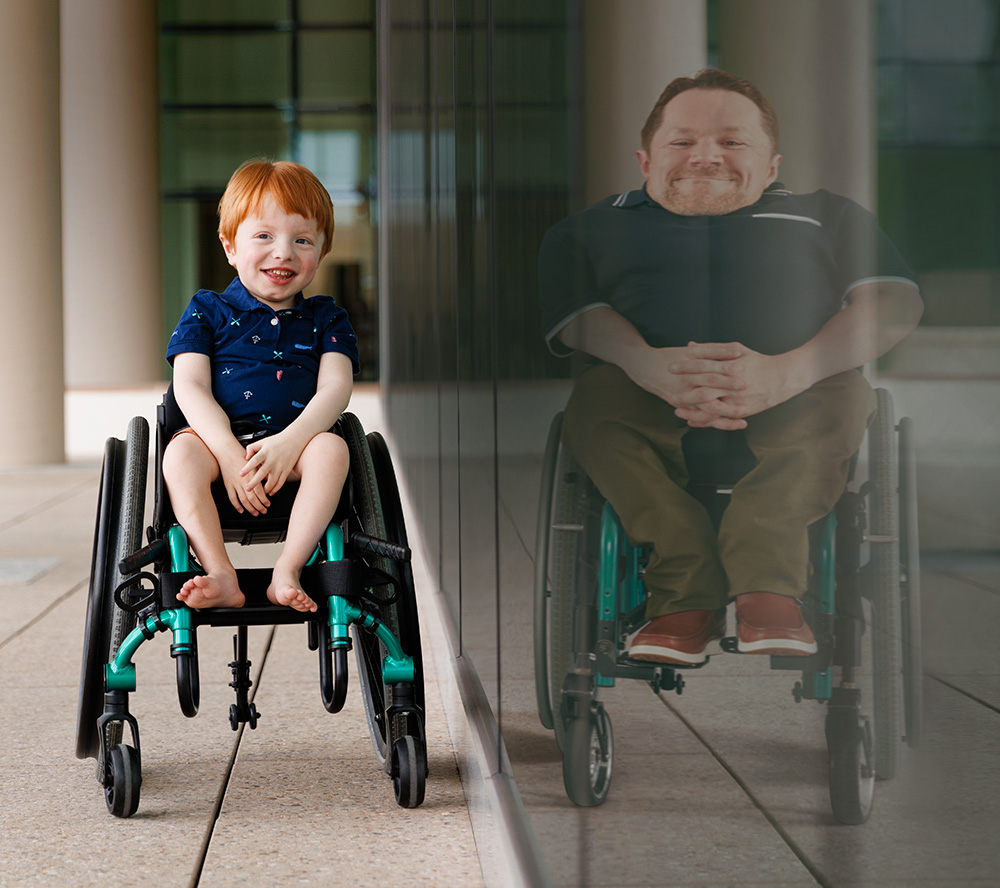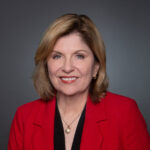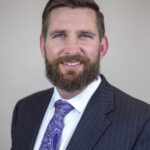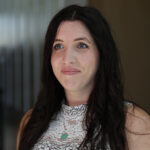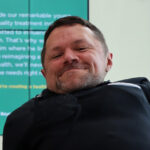At Nemours Children’s Hospital, Florida, associates (staff) and patients celebrated “Well Beyond Medicine Day” with some very honored guests. These VIPs stopped by the podcast to talk about osteogenesis imperfecta (OI), a genetic disease in which bones fracture (break) easily, often with no obvious cause or minimal injury.
Detroit resident Stephen Sheehy is a remarkable man who answered the Nemours Children’s Health call for an adult male with OI to be part of the Nemours Children’s “Reflections” ad campaign. Already lined up was 4-year-old Nemours OI patient MJ Strickland. Guest host Cheryl Munn boarded our mobile Well Beyond Medicine podcast truck to talk with Steve, MJ’s mom Alex Rice, and the leader of MJ’s care team, Nemours orthopedic surgeon Dr. Alec Stall about OI: how it’s diagnosed and treated today versus when Steve was growing up in the ’70s and ’80s; barriers faced and overcome; the importance of community connection; and how Steve became a model for Nemours.
Thanks for tuning in today! How do you go well beyond medicine? How do you celebrate it? Please visit NemoursWellBeyond.org to submit a comment or leave a voicemail — you just might be featured on an upcoming episode of the show. You can also catch all of our episodes at NemoursWellBeyond.org and sign up for our monthly newsletter.
Carol Vassar, producer
Cheryl Munn, host
Guests:
Stephen Sheehy, husband, father and adult living with OI
Alexandra “Alex” Rice, mom to Nemours Children’s Health patient MJ
Alec Stall, MD, Vice Chair, Department of Pediatric Orthopaedics and Orthopaedic Surgeon, Nemours Children’s Hospital, Florida
Well Beyond Medicine Episode 27, Transcript
Carol Vassar, podcast host/producer (00:00):
Welcome to Well Beyond Medicine, the Nemours Children’s Health podcast. Each week, we’ll explore anything and everything related to the 80% of child health impacts that occur outside the doctor’s office. I’m your host, Carol Vassar. And now that you are here, let’s go.
MUSIC (00:26):
Well Beyond Medicine!
Carol Vassar, podcast host/producer (00:27):
At Nemours Children’s Hospital in Orlando recently, staff and patients celebrated Well Beyond Medicine Day with some very honored guests, who we are pleased to have join us on this episode of the podcast. Steve Sheehey is a remarkable man who answered the Nemours call out for an adult male with osteogenesis imperfecta, OI, more commonly known as brittle bone disease. The reason? To be part of the Nemours Reflections campaign. Already lined up for the campaign was four-year-old Nemours OI patient MJ Strickland, a dynamite young man who has become known as the mayor of NCH Orlando and, really, the entire area of Orlando known as Lake Nona.
(01:14):
Nemours’ Cheryl Munn boarded the Mobile Well Beyond Medicine Podcast truck to talk with Steve, MJ’s mom, Alex Rice, and the leader of MJ’s care team, Nemours’ orthopedic surgeon, Dr. Alec Stall, about OI. How is it diagnosed and treated today versus when Steve was growing up in the ’70s and ’80s? Barriers faced and overcome, particularly in the realm of education. The importance of community connection and how exactly Steve, who lives in Detroit, Michigan, became a Nemours model. Steve Sheehey explains.
Steve Sheehey (01:55):
Well, I was contacted by a friend of mine who is active in the OI Foundation, and they had said that they were looking for an adult male with OI, and I was like, “Hey, I know someone like that. That’s me.” So, she had given me the contact information. She’s the widow of a friend of mine who also had OI, and she and I talked about it, and so I called the number she gave me, and here we are, and it’s been a wonderful experience. It was fun. Everybody was very professional, and it was quite eye-opening for me to get that many pictures taken of me. And it was interesting seeing the whole process of it and getting to know everybody. I heard the people from Nemours. I was a little nervous going in because I’d never done anything like it, but it was an interesting and fun afternoon.
Cheryl Munn, Nemours Children’s Health (02:52):
Yeah, you really did a great job. We had some beautiful ads.
Steve Sheehey (02:55):
Oh, well, thank you.
Cheryl Munn, Nemours Children’s Health (02:56):
Yeah. So, I’m going to move to Dr. Stall and ask you, what is osteogenesis imperfecta? How is it diagnosed? How is it treated?
Dr. Alec Stall, Nemours Children’s Health (03:06):
Literally translated, osteogenesis imperfecta means imperfectly formed bone. It’s a group of genetic disorders that are characterized by bone fragility. There’s a wide range of severity. Some are very mild and some very severe. In terms of diagnosis, it’s ultimately a clinical diagnosis based on history, physical exam, radiographic findings. There’s been incredible advancements in our genetic detection, and so many forms of OI can be confirmed genetically, but not all.
Cheryl Munn, Nemours Children’s Health (03:38):
How has the treatment changed over the years?
Dr. Alec Stall, Nemours Children’s Health (03:41):
When I started my training, there was really no medical management for osteogenesis imperfecta, say for bone health optimization, trying to optimize calcium and vitamin D, but no real treatments. Bisphosphonates have really transformed the care of OI over the past couple of decades. There’s some exciting new medications to the pipeline that work differently that I think we’re all excited about. There’s been significant advancement in surgical options for stabilization in OI. The implants themselves are more predictable and easier to use and have helped many kids that we didn’t have access to previously.
Cheryl Munn, Nemours Children’s Health (04:23):
Steven, tell me about some of the barriers.
Steve Sheehey (04:26):
Yeah. When I was born a long time ago in the 1970s, and there really was not a whole lot known at the time in terms of research and prognosis. I myself was born with nine broken bones and a dislocated hip, so the doctors knew right away. However, at the time, there were still a lot of cases where it wasn’t diagnosed right away, and so there was a misdiagnosis of child abuse, children would fracture… But there just wasn’t much of a prognosis at the time. The doctors had given my mom when she met with them, they said, “Well, don’t expect much. He might not be able to sit up. Might not be able to go to school.” But my mom, she’s a feisty lady, and she basically stormed out of the meeting and said, “Nope. Nope, that’s not right. That’s not what’s going to happen.”
(05:22):
So, she raised me as just an average kid, but there were barriers at the time in terms of education, the Americans with Disabilities Act had not been passed, so she had a lot of fights in the schools to get me into mainstream classes. That was relatively new at the time. So, there were a lot of barriers just with education, but it definitely helped having a mom that didn’t like the word no, being told, “No, you can’t do this.” Through all the challenges, I still had as normal a childhood as I could, and she made sure of that.
Cheryl Munn, Nemours Children’s Health (06:00):
I love that. And I also overheard you say that you moved around a lot, so she had to re-fight that battle over and over, didn’t she?
Steve Sheehey (06:06):
She did quite a bit. I was born and raised in the Detroit area mostly, but as a child, we moved around to Boston and Chicago. And you’re right, every time I was at a new school, they had to get a new IEP. And it was interesting for her to see just the vast difference in how different school districts treated and had services available to kids with disabilities. So, yeah, it was a fight.
Cheryl Munn, Nemours Children’s Health (06:32):
Well, I hope things are better. I’m going to talk to you a little bit, Alex. Let’s start with what went through your mind when MJ was first diagnosed.
Alex Rice (06:41):
Well, he was diagnosed when I was 20 weeks pregnant, the first anatomy study that they did or anatomy scan. And they noticed that his long bones were measuring short. So, we waited a couple of weeks, and they started measuring shorter and shorter, and we finally did genetic testing, and I think it was at 28 weeks, it came back that he was positive for OI type four. It was really scary at the time because no one really had any facts or expectations that they could give us. It was kind of vague that, “He might be severe, he might not, he might have broken bones, he may not. We don’t really know what to tell you.”
(07:20):
They didn’t see anything when they did the sonograms, and he ended up being born with five broken bones, both femurs, humerus, tibia, and a clavicle. And kind of to piggyback off what Steven said, when he was born, one of the doctors came in, and she’s like, “Oh, you’ll never be able to put clothes on him. He’ll never do this. He’ll never do that.” And I mean, as you’ve seen, the mayor of Lake Nona, he’s spunky and vivacious and…
Cheryl Munn, Nemours Children’s Health (07:52):
Yeah, he was doing wheelies down the hall. I love that. And going, “Let’s go. Playroom, I’m in. Let’s go.” So, that was amazing. So, after the diagnosis, how did your world shift?
Alex Rice (08:04):
A lot changed. I had to quit my job. Finding care for him wasn’t possible. So, yeah, just staying home and trying to navigate the school system is what we’re doing now, and finding appropriate care for him in a mainstream classroom. And him being able to get the education that he deserves, it’s still a fighting point that we have to advocate for because a lot of people still don’t know about OI, and they think everyone’s the same kind of across the board. People I run into they don’t understand that there’s so much difference between the types and a type four kid. One can be walking, one can be in a wheelchair. It’s just all very different.
Cheryl Munn, Nemours Children’s Health (08:42):
Steve, let me ask you a little bit about the differences between when you were diagnosed and how you’ve experienced your son also being diagnosed.
Steve Sheehey (08:52):
In terms of the services available for, especially in the school, it seems to be vastly different and better, all for the better now. The school district my son is in, my son Christopher, he’s going into the fifth grade. But right at the start from kindergarten, they had an IEP, and they had a whole tool ready to work with us. It’s a physical therapist who we’re friends with anyway, which turned out very nicely. He was a great guy. And OT and social work and just whatever we needed. I don’t recognize the way it was when I was in kindergarten and all the way through fifth grade. So, we’re just very thankful for all the groundwork that’s been laid for kids nowadays.
(09:41):
And when we started originally, the school, you could tell they were very cautious because when they hear the child with OI that has brittle bones, they want to be very cautious, and so they were quite cautious, especially being around kindergartners. And my son, Christopher, is ambulatory. He isn’t able to walk. And so, they were very concerned that kids would run into him and can knock him down, or as we all know, if a child with IO falls, that’s a very bad thing. It’s not just scrape yourself off. It’s six weeks of recovery from a fracture. So, they were just being very cautious. So, he had an aid with him all the time, a paraprofessional. But as he got older and as his fellow students got older and more responsible for their own actions, he hasn’t needed the paraprofessional. And so, now he’s in a mainstream class, has always been in a mainstream class I should say, but just pretty much on his own. It’s just wonderful, the programs they have,
Cheryl Munn, Nemours Children’s Health (10:39):
Dr. Stall?
Dr. Alec Stall, Nemours Children’s Health (10:40):
Well, I think that there’s been a couple of substantial changes that have already occurred that we haven’t really discussed. I think that our interconnectivity through the internet and through other mediums have really connected one, a lot of families, but also a lot of professionals. And so, OI is a rare condition, and the more that we can pool our knowledge and our experience, the better care and understanding that we can provide. So, it’s much, much easier to disseminate information and expertise and resources than I judge it previously was. I suspect that Steve was kind of on an island growing up, and I think that that is probably not true for most families now. So, I think that that’s been a huge advancement.
(11:22):
I mentioned this earlier, but there are some exciting medications and other medical treatments that have happened that are in the pipeline that I think are very promising. The results are early, but they’re very encouraging, and it takes a long time to get a medication from development to widespread application. And it takes 20 years to get 20-year outcomes. So, it’s going to take a while to really know if the short-term benefits outweigh any long-term concerns. We’ve seen in other rare conditions, though there’s been really tremendous advancements in genetic treatments. I think about another condition called spinal muscular atrophy, where there were no treatments at all ten, fifteen years ago. And now there’s a very effective intrathecal injection and even a gene therapy that has a single treatment, though very expensive, essentially mitigates that entire condition.
(12:15):
And I suspect that, in my lifetime, we will see the introduction of true gene therapies for OI. The heterogeneity of OI makes that a little bit challenging to apply to everybody because, for every genetic defect, you have to have another treatment for that. But for the more common types, OI type one, even three and four, that are well-characterized, they’re all collagen-based. I suspect in my lifetime that we’ll see, if not a cure, a very durable, substantial treatment.
Cheryl Munn, Nemours Children’s Health (12:50):
Alex, I want to ask you a little bit. You probably felt very much on an island. That is one bonus of social media and outreach. Has that helped, or have you used it at all?
Alex Rice (13:01):
Yes, social media has been great. On Facebook, there’s an OI parents group. And it’s parents all over the country, all over the world, talk to other parents and families in Europe, Nepal, Australia. I mean, they’re everywhere. And it’s nice to be able to communicate and what do you do there? What are you doing here? And just being able to talk about daily struggles or different ideas, viewpoints. MJ lost a tooth the other day and I was worried. So I went on the OI parents group, and I’m like, “Hey, what do you guys think about this?” And it’s just nice being able to reach out. And we have this little family, and most of the people I’ve never met in person, but we talk enough that I feel like I’ve known them forever.
Cheryl Munn, Nemours Children’s Health (13:42):
So, a new mother whose child is diagnosed with OI, what would you recommend?
Alex Rice (13:48):
Reaching out and talking to the other moms. There was specifically a group that we all had babies at the same time, and they’re my closest friends now. I mean, they’re who I reach out to, and having their support really means everything. And finding a good medical team that stands behind you and is supportive is life-changing. MJ didn’t have a good medical team for his first year, and it was a struggle. He had a hard time, and it was hard on us. And now he’s just blossomed, and the amount of support and love is just something that you’d be forever grateful for.
Cheryl Munn, Nemours Children’s Health (14:26):
And by good medical team, you mean Dr. Stall, right?
Alex Rice (14:29):
Yeah. Yeah.
Cheryl Munn, Nemours Children’s Health (14:31):
Okay, great. How can the community help spread awareness and understanding? Is there something other people can do to help?
Steve Sheehey (14:41):
The internet is a huge way now. Growing up, we didn’t have the internet, of course, and I was kind of on an island in some ways. The OI Foundation was my only contact with other people with OI. And I would go to an OI clinic, Shriners in Chicago, and that’s where I met other people with OI, and that was almost the highlight of my year as a kid because it was the only time I would see other kids with OI. And then, as an adult, I started going to the OI Conference, and that was huge for me. Just meeting other people and becoming friends with other people as adults with OI. But your families there and just seeing everybody, and it’s a common, shared experience of having to worry about a broken bone when you go travel or when you go to the store, or just go outside to play. Not everybody has that.
(15:36):
So, to have that as the shared common experience is just really, really big. So, social media, the internet is huge now. You can find people from around the globe with OI and become friends with them. My wife and I have friends in Australia who we never met in person very well, may never meet in person, but yet they’re like friends that live next door because my wife chats with her all the time. And that is fostered and augmented by the internet and social media.
Dr. Alec Stall, Nemours Children’s Health (16:15):
I’d just like to give a small shout-out to actually the OI Foundation. The internet, it’s connected people. There’s a lot of good information, a lot of bad information. And over the years, the OI Foundation has been an incredible resource for patients, for physicians, for therapists, for anyone that’s involved. It’s really helped advance medical and surgical treatments. And so, in terms of educating people, I think first, people need to know that OI exists. And then, the second thing I would do is point them to the OI Foundation as a resource that’s pretty comprehensive and reliable.
(16:51):
The second thing, which is not to be a Debbie downer in this, but most children born with OI are spontaneous and don’t come from families with OI. And particularly in the milder forms of OI, in which children are not born with fractures. Fractures in early childhood commonly is attributed to abuse. It is an unfortunate truth that child abuse is much more common than OI. The consequence of that is that many parents are separated from their children that are not yet diagnosed with OI. And I know that that’s a really traumatic experience for everybody involved. And having awareness of the condition and the specifics of the types of fractures that they get and how they’re different and having that awareness, I think, can help people in general and healthcare professionals in particular, not separate families when they don’t need to be.
Alex Rice (17:47):
Kind of going to piggyback on Dr. Stall about what he said about the OI Foundation for new parents especially. They have so many resources on there and files that you can print out and take to a doctor. When MJ first started going to therapy, there was a four-page packet that I took that I was like, “Here, this is from the OI Foundation to help you out.” Because his one therapist had never dealt with someone that had OI, but she was willing to learn, and now she’s been with them for five years, and she’s phenomenal. So, it is a great resource.
Steve Sheehey (18:18):
I feel like I need to give a shout-out to the OI Foundation as well. I am sensing a theme here. I met my wife at the OI Foundation Conference. So, she was a widow, and her son had OI, and so she was there, and we met at an event and just hit it off, and, well, we’re married.
Cheryl Munn, Nemours Children’s Health (18:38):
Oh, that’s awesome. You have a real great life with how many kids?
Steve Sheehey (18:44):
I have two kids. My son with OI, who technically is my stepson, but he’s my son. And then, my wife and I had a boy three years ago, and he does not have OI. Life definitely has its challenges for sure, but it has challenges for everybody. And it’s like, well, what are your challenges? And for some people, their challenges are invisible. Mine aren’t. Everybody knows it’s hard for me to go up a flight of stairs. Well, it’s impossible to go up a flight stairs, but it’s worth it. I’ve had one of my best friends since the eighth grade, and we were friends in high school, I was on the debate team, and we were the first debate team in our school’s history to make it to the state finals.
(19:29):
And then, I went away to college, and I lived in the dorms there, and I met another best friend of mine, and we were roommates for four years, and we’re still best friends. And then I went away to grad school and lived on my own. And all this was stuff that my parents had… The mindset was, “You’re going to live a normal life. How can we help you get there?” Had to have been insanely difficult for my parents to let me go away to college and live on my own. And once I graduated from undergrad, I lived in Cincinnati, which was five hours away. How did they do that? Now that I’m a parent, I don’t know how they did that, but they’re amazing. Life is worth it. It’s difficult. But now I am working. I have a full-time job and been in IT for over 20 years. Married; have a house; pay my taxes. You know what I mean? Tell kids to “Get off my lawn,” all that kind of stuff. It’s fun.
MUSIC (20:29):
Well beyond medicine
Carol Vassar, podcast host/producer (20:31):
Thanks for listening and celebrating Nemours Well Beyond Medicine Day with me, Carol Vassar, guest interviewer Cheryl Munn, and our honored guests, Steve Sheehey, Alex Rice, and Dr. Alec Stall. How do you go well beyond medicine? How do you celebrate it? Visit nemourswellbeyond.org to submit a comment or leave a voicemail. That’s nemourswellbeyond.org. While you’re there, check out our other episodes and be sure to subscribe to the podcast. Thanks, as always, to Che Parker and Susan Masucci for their production assistance. And to Cheryl Munn, I give kudos for stepping into the interviewer portion of this episode. Join us next time for an encore episode about the Nemours Can Grow Garden, a great example of going well beyond medicine. Until then, remember together we can change children’s health for good. Well Beyond Medicine.
MUSIC (21:29):
Well Beyond Medicine
